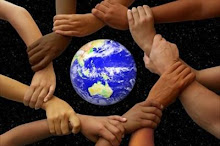Shared beliefs, values, norms, and social practices that are stable over time and that lead to roughly similar behaviors across similar situations are known as Cultural Patterns.
Ex: You know how every time an african American christian extended family gets together they have a long prayer by the family elder... (yep we all do that)
A Belief is an idea that people assume to be true about the world. Beliefs therefore, are a set of learned interpretations that form the basis for cultural members to decide what is and what is not logical and correct.
Ex: American Values could also be called American Beliefs because collectively we have just as much of a belief system; americans have a general outlook as well as system of values which are individual ideas on what is good or bad ying or yang.
- Central beliefs include the culture's fundamental teachings about what reality is and expectations about how the world works.
- Peripheral beliefs refer to matters of personal taste. They contribute to each person's unique configuration of ideas and expectations within the larger cultural matrix.
Cultures differ not only in their beliefs but also in what they value. Values involve what a culture regards as good or bad, right or wrong, fair or unfair, just or unjust, beautiful or ugly, clean or dirty, valuable or worthless, appropriate or inappropriate, and kind or cruel.
Ex: I was raised as a Jehovah's Witness and so i have a set of values that are based on my religious up bringing.
- Valence refers to whether the value is seen as positive or negative.
- Intensity indicates the strength or importance of the value, or the degree to which the culture identifies the value as significant
Norms are the socially shared expectations of appropriate behaviors.
Social practices are the predictable behavior patterns that members of a culture typically follow.
Kluckhohn and Strodtbeck's Value Orientations
Orientation Postulated Range of Variations
Ac t i v i t y Being Being-in-becoming Doing
Relationships Linearity Collaterality Individualism
Human natureEvil Mixture of good and evil Good
People-nature Subjugation to nature Harmony with nature Mastery over nature
Time Past Present Future
An Activity Orientation defines how the people of a culture view human actions and the expression of self through activities. This orientation provides answers to questions such as the following
- Is it important to be engaged in activities in order to be a "good" member of one's culture?
- Can and should people change the circumstances of their lives?
- Is work very different from play?
- Which is more important,work or play?
- Is life a series of problems to be solved or simply a collection of events to be experienced?
The Social Relations Orientation describes how the people in a culture organize themselves and relate to one another. This orientation provides answers 10 questions such as the following;
To what extent are some people in the culture considered better or superior to others?
- Can social superiority be obtained through birth, age, good deeds, or material achievement and success?
- Are formal , ritualized interaction sequences expected?
- In what ways does the culture's language require people to make social distinctions?
- What responsibilities and obligations do people have to their extended families,
their neighbors, their employers or employees, and others?
A social relations orientation can range from one that emphasizes differences and social hierarchy 10 one thai strives for equality and the absence of hierarchy.
Self-orientation describes how people's identity are formed, whether the culture views the self as changeable, what motivates individual actions, and the kinds of people who are valued and respected. A culture's self-orientation provides answers to questions such as the following:
- Do people believe they have their own unique identities that separate them from others?
- Does the self reside in the individual or in the groups to which the individual belongs?
- What responsibilities does the individual have to others?
- What motivates people to behave as they do?
- Is it possible to respect a person who is judged "bad" in one part of life but is
- successful in another part of life?
Cultural patterns also tell people how to locate themselves in relation to the spiritual world, nature, and other living things. A World Orientation provides answers to questions such as the following:
- Are human beings intrinsically good or evil?
- Are humans different from other animals and plants?
- Are people in control of, subjugated by,or living in harmony with the forces of nature?
- Do spirits of the dead inhabit and affect the human world?
The final aspect of cultural patterns concern show people conceptualize time. Time orientation provides answers to questions such as the following:
- How should time be valued and understood?
- Is time a scarce resource, or is it unlimited?
- Is the desirable pace of life fast or slow?
- Is time linear or cyclical?






0 comments:
Post a Comment